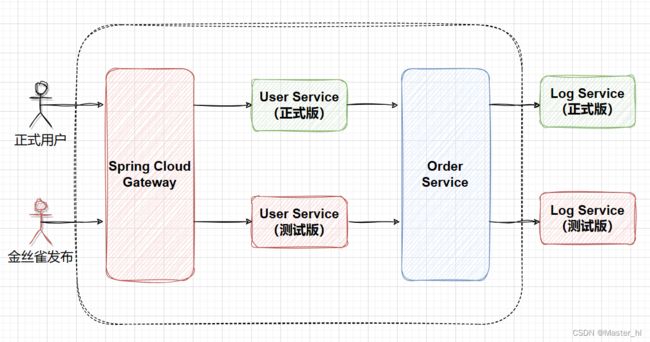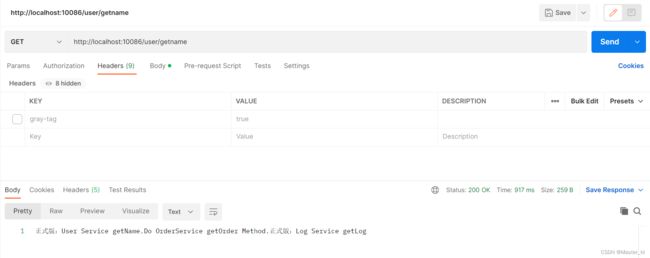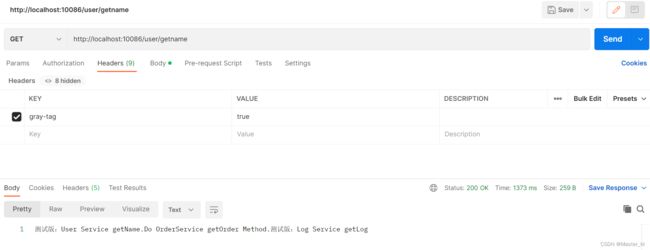在微服务中如何实现全链路的金丝雀发布?
目录
1. 什么金丝雀发布?它有什么用?
2.如何实现全链路的金丝雀发布
2.1 负载均衡模块
2.2 网关模块
2.3 服务模块
2.3.1 注册为灰色服务实例
2.3.2 设置负载均衡器
2.3.3 传递灰度发布标签
2.4 其他代码
2.4.1 其他业务代码
2.4.2 pom.xml 关键代码
2.4.3 application.yml 相关代码
3. 验证全链路金丝雀发布的实现效果
1. 什么金丝雀发布?它有什么用?
金丝雀发布(Canary Release,也称为灰度发布)是指在软件或服务发布过程中,将新版本的功能或服务以较小的比例引入到生产环境中,仅向部分用户或节点提供新功能的一种发布策略。
而在传统的全量发布中,新版本将会立即部署到所有用户或节点上。金丝雀发布的核心思想是逐步推进,监测新版本的稳定性和性能,以确保在全面发布之前能够解决潜在的问题。
假设某款在线多人游戏决定上线一个全新的多人模式功能。在传统的全量发布中,它会将这个新功能立即部署到所有玩家的游戏客户端中,然后在全面发布后等待用户的反馈。而使用金丝雀发布,它的发布流程就变成了这样:
内测阶段:
- 游戏开发团队首先将新多人模式功能引入到游戏的内测版本中,但仅向少数特定的内测玩家提供。
- 这些内测玩家是经过筛选或自愿参与的,他们了解可能会遇到问题,并愿意分享反馈。
- 内测玩家可以在一定时间内使用新功能,并向开发团队报告问题、提供建议和反馈意见。
监测和改进:
- 游戏开发团队密切关注内测玩家的游戏体验、性能和稳定性。
- 如果在内测期间发现了问题,团队可以及时进行修复和改进,并确保新功能在全面发布前达到高质量标准。
逐步扩展:
- 在确认新功能在内测阶段表现良好后,开发团队逐步扩展金丝雀发布的范围。
- 他们可以将新功能提供给更多的玩家,但仍然限制在一小部分,比如10%的玩家。
- 这一阶段被称为金丝雀发布的初期阶段,新功能仅对一小部分用户可见。
全面发布:
- 在经过一系列逐步扩展和监测后,开发团队最终将新多人模式功能发布给了所有玩家。
- 此时,新功能已经通过了多轮测试和改进,用户体验较好,且潜在问题得到了解决。
从上述游戏上线新功能的金丝雀发布流程中能看出,金丝雀发布相比传统的全量发布有以下好处:
- 逐步引入新功能,降低全面发布的风险。
- 及时获取内测玩家的反馈,加速问题的修复。
- 确保新功能在全面发布时达到高质量标准。
- 提供更好的用户体验,减少潜在问题对所有用户的影响。
2.如何实现全链路的金丝雀发布
Spring Cloud 全链路金丝雀发布的实现思路图如下:
金丝雀发布的具体实现步骤大致分为以下几步:
- 前端程序在灰度测试的用户 Header 头中打上标签,例如在 Header 中添加 "gray-tag:true",表示要访问灰度服务,其他则为正式服务。(前端)
- 在负载均衡器 Spring Cloud LoadBalancer 中,拿到 Header 中的 "gray-tag" 进行判断,如果此标签不为空,并且等于 "true" 的话,则表示要访问灰度发布的服务,否则只访问正式的服务。(客户端负载均衡)
- 在网关 Spring Cloud Gateway 中,将 Header 标签 "gray-tag:true" 传递到下一个调用的服务。(网关)
- 后续的服务调用中,还需要做两件事:(内部服务)
- 在 Spring Cloud LoadBalancer 中,判断灰度发布标签,将请求分发给对应的服务。
- 在内部的服务调用过程中,传递灰度发布标签。
由此可见,全链路的灰色发布只需要解决两个大问题:
1. Gateway 中的问题
- Gateway 的调度转发问题。
- Gateway 灰色发布标签的传递问题。
2. 内部服务中的问题
- 服务的灰度转发问题。
- 服务内部灰色发布标签的传递问题。
【金丝雀发布代码案例】
根据 Spring Cloud 全链路金丝雀发布的实现思路图来编写代码,
创建 Spring 多模块项目,然后准备 7 个模块:user-service、new-user-service、order-service、log-service、new-log-service、gray-loadbalancer、gateway。
2.1 负载均衡模块
操作 gray-loadblancer 模块,这个模块作为一个公共模块,可以不需要启动类。
① 自定义负载均衡器
这里可以参考默认的轮询负载均衡策略里面的实现:
- 实现 ReactorServiceInstanceLoadBalancer 接口
- 复制其他代码,修改关键地方的类名
- 重写 getInstanceResponse 方法
import org.apache.commons.logging.Log;
import org.apache.commons.logging.LogFactory;
import org.springframework.beans.factory.ObjectProvider;
import org.springframework.cloud.client.ServiceInstance;
import org.springframework.cloud.client.loadbalancer.*;
import org.springframework.cloud.loadbalancer.core.*;
import org.springframework.http.HttpHeaders;
import reactor.core.publisher.Mono;
import java.util.List;
import java.util.Random;
import java.util.concurrent.atomic.AtomicInteger;
/**
* 定义灰度发布的负载均衡算法
*/
public class GrayLoadBalancer implements ReactorServiceInstanceLoadBalancer {
private static final Log log = LogFactory.getLog(GrayLoadBalancer.class);
private final String serviceId;
private AtomicInteger position; // 下标
private ObjectProvider serviceInstanceListSupplierProvider;
public GrayLoadBalancer(ObjectProvider serviceInstanceListSupplierProvider, String serviceId) {
this.serviceId = serviceId;
this.serviceInstanceListSupplierProvider = serviceInstanceListSupplierProvider;
this.position = new AtomicInteger(new Random().nextInt(1000));
}
public Mono> choose(Request request) {
ServiceInstanceListSupplier supplier = (ServiceInstanceListSupplier)this.serviceInstanceListSupplierProvider.getIfAvailable(NoopServiceInstanceListSupplier::new);
return supplier.get(request).next().map((serviceInstances) -> {
return this.processInstanceResponse(supplier, serviceInstances,request);
});
}
private Response processInstanceResponse(ServiceInstanceListSupplier supplier,
List serviceInstances,
Request request) {
Response serviceInstanceResponse = this.getInstanceResponse(serviceInstances,request);
if (supplier instanceof SelectedInstanceCallback && serviceInstanceResponse.hasServer()) {
((SelectedInstanceCallback)supplier).selectedServiceInstance((ServiceInstance)serviceInstanceResponse.getServer());
}
return serviceInstanceResponse;
}
private Response getInstanceResponse(List instances,Request request) {
if (instances.isEmpty()) {
if (log.isWarnEnabled()) {
log.warn("No servers available for service: " + this.serviceId);
}
return new EmptyResponse();
} else {
// 灰度业务的实现
// 0.得到 Request 对象 [通过方法参数的传递拿到此对象]
// 1.从 Request 对象的 Header 中得到灰度标签
RequestDataContext requestDataContext = (RequestDataContext) request.getContext();
HttpHeaders headers = requestDataContext.getClientRequest().getHeaders();
// 获取名为 "gray-tag" 的头部信息的值
List headersList = headers.get(GlobalVariable.GRAY_TAGE);
if (headersList != null && !headersList.isEmpty() &&
headersList.get(0).equals("true")) { // 灰度请求
// 灰度列表
List grayList = instances.stream().
filter(i -> i.getMetadata().get(GlobalVariable.GRAY_TAGE) != null &&
i.getMetadata().get(GlobalVariable.GRAY_TAGE).equals("true")).
toList();
if(!grayList.isEmpty()) {
instances = grayList;
}
} else { // 正式节点
// 2.将实例进行进行分组 【生产服务列表|灰度服务列表】
instances = instances.stream(). // 取反
filter(i -> i.getMetadata().get(GlobalVariable.GRAY_TAGE) == null ||
!i.getMetadata().get(GlobalVariable.GRAY_TAGE).equals("true")).
toList();
}
// 3.使用负载均衡算法选择上一步列表中的某个节点
int pos = this.position.incrementAndGet() & Integer.MAX_VALUE;
ServiceInstance instance = instances.get(pos % instances.size());
return new DefaultResponse(instance);
}
}
} /**
* 全局变量
*/
public class GlobalVariable {
public static final String GRAY_TAGE = "gray-tag";
}
② 封装负载均衡器
import org.springframework.cloud.client.ServiceInstance;
import org.springframework.cloud.loadbalancer.core.ReactorLoadBalancer;
import org.springframework.cloud.loadbalancer.core.ServiceInstanceListSupplier;
import org.springframework.cloud.loadbalancer.support.LoadBalancerClientFactory;
import org.springframework.context.annotation.Bean;
import org.springframework.core.env.Environment;
/**
* 封装灰度发布负载均衡器
*/
public class GrayLoadBalancerConfig {
@Bean
public ReactorLoadBalancer grayLoadBalancer(Environment environment, LoadBalancerClientFactory loadBalancerClientFactory) {
String name = environment.getProperty(LoadBalancerClientFactory.PROPERTY_NAME);
// 灰度发布的负载均衡器
return new GrayLoadBalancer(
loadBalancerClientFactory.getLazyProvider(name,
ServiceInstanceListSupplier.class), name);
}
}
2.2 网关模块
通过全局过滤器,来判断或设置灰度标识,
import com.loadbalancer.gray.GlobalVariable;
import org.springframework.cloud.gateway.filter.GatewayFilterChain;
import org.springframework.cloud.gateway.filter.GlobalFilter;
import org.springframework.http.server.reactive.ServerHttpRequest;
import org.springframework.http.server.reactive.ServerHttpResponse;
import org.springframework.stereotype.Component;
import org.springframework.web.server.ServerWebExchange;
import reactor.core.publisher.Mono;
@Component
public class LoadBalancerFilter implements GlobalFilter {
@Override
public Mono filter(ServerWebExchange exchange, GatewayFilterChain chain) {
// 得到 request、response 对象
ServerHttpRequest request = exchange.getRequest();
ServerHttpResponse response = exchange.getResponse();
// 判断灰度标签
String tag = request.getQueryParams().getFirst(GlobalVariable.GRAY_TAGE);
if(tag != null) {
// 设置灰度标识
response.getHeaders().set(GlobalVariable.GRAY_TAGE,"true");
}
// 此步骤正常,执行下一步
return chain.filter(exchange);
}
}
2.3 服务模块
2.3.1 注册为灰色服务实例
将测试版的服务,注册为灰色服务实例:new-user-service、new-log-service
spring:
application:
name: user-service-gray
cloud:
nacos:
discovery:
server-addr: localhost:8848
username: nacos
password: nacos
metadata: {"gray-tag": "true"} # 金丝雀标识
server:
port: 02.3.2 设置负载均衡器
在服务启动类上设置负载均衡和开启 OpenFeign 服务:user-service、new-user-service、order-service。
import com.loadbalancer.gray.GrayLoadBalancerConfig;
import org.springframework.boot.SpringApplication;
import org.springframework.boot.autoconfigure.SpringBootApplication;
import org.springframework.cloud.loadbalancer.annotation.LoadBalancerClients;
import org.springframework.cloud.openfeign.EnableFeignClients;
@SpringBootApplication
@EnableFeignClients
@LoadBalancerClients(defaultConfiguration =
GrayLoadBalancerConfig.class)
public class UserServiceApplication {
public static void main(String[] args) {
SpringApplication.run(UserServiceApplication.class, args);
}
}在网关模块中设置负载均衡,
import com.loadbalancer.gray.GrayLoadBalancerConfig;
import org.springframework.boot.SpringApplication;
import org.springframework.boot.autoconfigure.SpringBootApplication;
import org.springframework.cloud.loadbalancer.annotation.LoadBalancerClients;
@SpringBootApplication
@LoadBalancerClients(defaultConfiguration =
GrayLoadBalancerConfig.class)
public class GatewayApplication {
public static void main(String[] args) {
SpringApplication.run(GatewayApplication.class, args);
}
}
2.3.3 传递灰度发布标签
在服务内部传递灰度发布标签:user-service、new-user-service、order-service
方式一:传递request中所有的header,所有的header中就包含了灰度发布标签。
import feign.RequestInterceptor;
import feign.RequestTemplate;
import jakarta.servlet.http.HttpServletRequest;
import org.springframework.stereotype.Component;
import org.springframework.web.context.request.RequestContextHolder;
import org.springframework.web.context.request.ServletRequestAttributes;
import java.util.Enumeration;
@Component
public class FeignRequestInterceptor implements RequestInterceptor {
@Override
public void apply(RequestTemplate requestTemplate) {
// 从 RequestContextHolder 中获取 HttpServletRequest
ServletRequestAttributes attributes = (ServletRequestAttributes)
RequestContextHolder.getRequestAttributes();
HttpServletRequest request = attributes.getRequest();
// 传递所有的 header,就包含了灰度发布标签
Enumeration headerNames = request.getHeaderNames();
while(headerNames.hasMoreElements()) {
String key = headerNames.nextElement();
String value = request.getHeader(key);
requestTemplate.header(key,value);
}
}
} 方式二:只传递header中的灰度发布标签
import feign.RequestInterceptor;
import feign.RequestTemplate;
import jakarta.servlet.http.HttpServletRequest;
import org.springframework.stereotype.Component;
import org.springframework.web.context.request.RequestContextHolder;
import org.springframework.web.context.request.ServletRequestAttributes;
import java.util.Enumeration;
import java.util.LinkedHashMap;
import java.util.Map;
@Component
public class FeignRequestInterceptor implements RequestInterceptor {
@Override
public void apply(RequestTemplate requestTemplate) {
// 从 RequestContextHolder 中获取 HttpServletRequest
ServletRequestAttributes attributes = (ServletRequestAttributes)
RequestContextHolder.getRequestAttributes();
// 获取 RequestContextHolder 中的信息
Map headers = getHeaders(attributes.getRequest());
// 放入 openfeign 的 requestTemplate 中
for(Map.Entry entry : headers.entrySet()) {
requestTemplate.header(entry.getKey(), entry.getValue());
}
}
/**
* 获取原请求头
*/
private Map getHeaders(HttpServletRequest request) {
Map map = new LinkedHashMap<>();
Enumeration enumeration = request.getHeaderNames();
if(enumeration!=null) {
while(enumeration.hasMoreElements()) {
String key = enumeration.nextElement();
String value = request.getHeader(key);
map.put(key,value);
}
}
return map;
}
}
2.4 其他代码
2.4.1 其他业务代码
① user-service 模块的 controller
import com.example.userservice.service.OrderService;
import org.springframework.beans.factory.annotation.Autowired;
import org.springframework.web.bind.annotation.RequestMapping;
import org.springframework.web.bind.annotation.RestController;
@RestController
@RequestMapping("/user")
public class UserController {
@Autowired
private OrderService orderService;
@RequestMapping("/getname")
public String getName() {
String result = orderService.getOrder();
return "正式版:User Service getName." +
result;
}
}
② user-service 模块的 service
import org.springframework.cloud.openfeign.FeignClient;
import org.springframework.stereotype.Service;
import org.springframework.web.bind.annotation.RequestMapping;
@FeignClient("order-service-gray")
@Service
public interface OrderService {
@RequestMapping("/order/getorder")
public String getOrder();
}
③ new-user-service 模块的 controller
import com.example.newuserservice.service.OrderService;
import org.springframework.beans.factory.annotation.Autowired;
import org.springframework.web.bind.annotation.RequestMapping;
import org.springframework.web.bind.annotation.RestController;
@RestController
@RequestMapping("/user")
public class UserController {
@Autowired
private OrderService orderService;
@RequestMapping("/getname")
public String getName() {
String result = orderService.getOrder();
return "测试版:User Service getName." +
result;
}
}
④ new-user-service 模块的 service
import org.springframework.cloud.openfeign.FeignClient;
import org.springframework.stereotype.Service;
import org.springframework.web.bind.annotation.RequestMapping;
@FeignClient("order-service-gray")
@Service
public interface OrderService {
@RequestMapping("/order/getorder")
public String getOrder();
}
⑤ order-service 模块的 controller
import com.example.orderservice.service.LogService;
import org.springframework.beans.factory.annotation.Autowired;
import org.springframework.web.bind.annotation.RequestMapping;
import org.springframework.web.bind.annotation.RestController;
@RestController
@RequestMapping("/order")
public class OrderController {
@Autowired
private LogService logService;
@RequestMapping("/getorder")
public String getOrder() {
String result = logService.getLog();
return "Do OrderService getOrder Method." +
result;
}
}
⑥ order-service 模块的 service
import org.springframework.cloud.openfeign.FeignClient;
import org.springframework.stereotype.Service;
import org.springframework.web.bind.annotation.RequestMapping;
@Service
@FeignClient("log-service-gray")
public interface LogService {
@RequestMapping("/log/getlog")
public String getLog();
}
⑦ log-service 模块的 controller
import org.springframework.web.bind.annotation.RequestMapping;
import org.springframework.web.bind.annotation.RestController;
@RestController
@RequestMapping("/log")
public class LogController {
@RequestMapping("/getlog")
public String getLog() {
return "正式版:Log Service getLog";
}
}⑧ new-log-service 模块的 controller
import org.springframework.web.bind.annotation.RequestMapping;
import org.springframework.web.bind.annotation.RestController;
@RestController
@RequestMapping("/log")
public class LogController {
@RequestMapping("/getlog")
public String getLog() {
return "测试版:Log Service getLog";
}
}
2.4.2 pom.xml 关键代码
① 父模块的 pom.xml
modules 中先加载服务调用链中靠后的服务,
pom
gray-loadbalancer
gateway
new-log-service
log-service
order-service
user-service
new-user-service
com.alibaba.cloud
spring-cloud-starter-alibaba-nacos-discovery
org.springframework.boot
spring-boot-starter-test
test
com.example
gray-loadbalancer
0.0.1-SNAPSHOT
② user-service 模块的 pom.xml
com.example
gray-demo
0.0.1-SNAPSHOT
org.springframework.boot
spring-boot-starter-web
org.springframework.cloud
spring-cloud-starter-openfeign
③ new-user-service 模块的 pom.xml
com.example
gray-demo
0.0.1-SNAPSHOT
org.springframework.boot
spring-boot-starter-web
org.springframework.cloud
spring-cloud-starter-openfeign
com.example
gray-loadbalancer
0.0.1-SNAPSHOT
③ order-service 模块的 pom.xml
com.example
gray-demo
0.0.1-SNAPSHOT
org.springframework.boot
spring-boot-starter-web
org.springframework.cloud
spring-cloud-starter-openfeign
com.example
gray-loadbalancer
0.0.1-SNAPSHOT
④ log-service 和 new-log-service 模块的 pom.xml
com.example
gray-demo
0.0.1-SNAPSHOT
org.springframework.boot
spring-boot-starter-web
⑤ gray-loadbalancer 模块的 pom.xml
com.example
gray-demo
0.0.1-SNAPSHOT
org.springframework.cloud
spring-cloud-starter-loadbalancer
org.springframework.boot
spring-boot-starter-web
⑥ gateway 模块的 pom.xml
com.example
gray-demo
0.0.1-SNAPSHOT
org.springframework.cloud
spring-cloud-starter-gateway
com.example
gray-loadbalancer
0.0.1-SNAPSHOT
2.4.3 application.yml 相关代码
① user-service 模块的 application.yml
spring:
application:
name: user-service-gray
cloud:
nacos:
discovery:
server-addr: localhost:8848
username: nacos
password: nacos
server:
port: 0
② new-user-servicce 模块的 application.yml
spring:
application:
name: user-service-gray
cloud:
nacos:
discovery:
server-addr: localhost:8848
username: nacos
password: nacos
metadata: {"gray-tag": "true"} # 金丝雀标识
server:
port: 0③ order-servicce 模块的 application.yml
spring:
application:
name: order-service-gray
cloud:
nacos:
discovery:
server-addr: localhost:8848
username: nacos
password: nacos
server:
port: 0
④ log-servicce 模块的 application.yml
spring:
application:
name: log-service-gray
cloud:
nacos:
discovery:
server-addr: localhost:8848
username: nacos
password: nacos
server:
port: 0⑤ new-log-servicce 模块的 application.yml
spring:
application:
name: log-service-gray
cloud:
nacos:
discovery:
server-addr: localhost:8848
username: nacos
password: nacos
metadata: {"gray-tag": "true"} # 金丝雀标识
server:
port: 0
⑥ gateway 模块的 application.yml
spring:
main:
web-application-type: reactive # Spring Web 和 reactive web 冲突
application:
name: gateway-gray
cloud:
nacos:
discovery:
server-addr: localhost:8848
username: nacos
password: nacos
register-enabled: false # 网关不需要注册到 nacos
gateway:
routes:
- id: user-service
uri: lb://user-service-gray
predicates:
- Path=/user/**
server:
port: 100863. 验证全链路金丝雀发布的实现效果
按顺序启动 log、order、user 的正式及测试服务,以及 gateway 模块,
使用 Postman 来验证全链路金丝雀发布的实现效果:
1. 请求头中不带 "gray-tag" 灰度标签,访问正式版服务
验证结果:无论访问多少次,不管是否服务集群,只要请求头中不带 "gray-tag" 灰度标签,只能访问到正式版的服务。
2. 请求头中带上 "gray-tag" 灰度标签,并且值为 true,访问测试版服务
验证结果:无论访问多少次,不管是否服务集群,只要请求头中带上 "gray-tag" 灰度标签,并且值为 true ,就只能访问到测试版的服务。
至此,微服务中全链路的金丝雀发布就实现好了~


